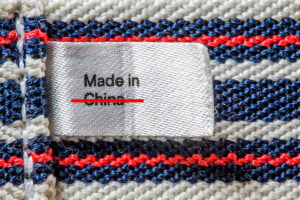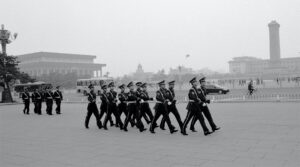Trying to predict what the Chinese system will look like as it collapses would be a fool’s errand, but exploring China’s housing market in this context could be fruitful.
China has an investment-based economic model, which means resources and capital go towards infrastructure development and construction. As Japan and Korea have shown us, this economic model isn’t sustainable; diminishing returns will settle in, and the economy will grow stagnant.
Japan and Korea had private enterprises to help the economy balance out, in addition to international investment opportunities. In the case of China, capital flight is restricted, so citizens look to speculative bubbles for investment opportunities…and housing is the most problematic of the bubbles.
And so Chinese citizens dumped their life savings into housing, generating the world’s most massive overbuild. As China collapses and people’s money is tied up in this useless real estate, it doesn’t take much to imagine what happens next. Let’s just say Xi might be losing some of his fan base.
Here at Zeihan On Geopolitics we select a single charity to sponsor. We have two criteria:
First, we look across the world and use our skill sets to identify where the needs are most acute. Second, we look for an institution with preexisting networks for both materials gathering and aid distribution. That way we know every cent of our donation is not simply going directly to where help is needed most, but our donations serve as a force multiplier for a system already in existence. Then we give what we can.
Today, our chosen charity is a group called Medshare, which provides emergency medical services to communities in need, with a very heavy emphasis on locations facing acute crises. Medshare operates right in the thick of it. Until future notice, every cent we earn from every book we sell in every format through every retailer is going to Medshare’s Ukraine fund.
And then there’s you.
Our newsletters and videologues are not only free, they will always be free. We also will never share your contact information with anyone. All we ask is that if you find one of our releases in any way useful, that you make a donation to Medshare. Over one third of Ukraine’s pre-war population has either been forced from their homes, kidnapped and shipped to Russia, or is trying to survive in occupied lands. This is our way to help who we can. Please, join us.
Transcript
Hey everybody. Peter Zeihan here comes to you from Colorado. A lot of you have been writing in and asking for scenarios of what the Chinese system will look like as it collapses. And Chinese history is rich with how it’s all going to hell. So putting my finger on one specific scenario I don’t think is very useful, but a lot of you have also written in asking about the Chinese housing market, and I think kind of exploring these two things hand in hand is worth a little bit of time.
So the Chinese follow a capital intensive investment model. There are there’s three types of economic growth. You’ve got consumption. Like you go out and you buy a home or you buy an iPod or whatever it happens to be. In the United States, that’s about 70% of total economic activity. Private consumption. Then you have exports. So, you know, you make something like Boeing and you sell it to the Indians.
Export led economic growth that is a system that is more popular in a place like, say, Korea or Germany. And then you have investment led economic growth, which is the building of stuff where regardless of where you get the capital, you get you build a road, you build a factory, something like that. And this has always been the method that has been favored in China and to a lesser degree, all of East Asia, because it’s something the government, for the most part, can control.
And it tends to be directed towards things that the government feels needs to be done. So roads, bridges, industrial plant and all of the East Asians have followed this pattern to a certain degree. The problem with this pattern and this type of growth is if you do it enough, you start to distort the economy and you absorb more and more capital and more and more labor and more and more resources.
And eventually you get to the point where there’s diminishing returns because you only need so many roads, you only need so many factories. In the case of Japan. They reached this point in the 1980s and they went from having stratospheric growth because this generates a lot of economic activity to just kind of a stall out. And they were left with a stack of loans worth about 50% of their GDP, $2 trillion at the time that was invested into assets that probably should have never been built in the first place.
And it took the Japanese system 30 years to churn through that, and that was 30 years of basically not having economic growth at all. Eventually, they realized the debt burden was so bad that they needed to focus what they could do on more productive stuff. And that turned out to be stuff that was not in Japan. And so we started this generation long outsourcing, the sourcing, whatever you want to call it, to countries that had better demographics and better debt profiles, most notably the United States.
And here we are now, 35 years after that process started. And the Japanese economy is more or less back in health. But it’s happened as the demographic situation has turned inside out. So consumption led growth in Japan will probably never happen again. They’re just too old. Something similar went down in Korea, but the Koreans attacked it with a fervor that the Japanese couldn’t muster, and they decided to deal with it by investing more, but going further and further up the value added chain.
And this could work in Korea because they were already among the most highly educated populations in the world, and they eventually generated things like the Samsung and the Daewoo and the Hyundai that we know today. It came at a cost. Extraordinary levels of turnover in the corporate world as entire chaebol, which are kind of giant industrial conglomerates, would go bust, which would generate a huge surge of unemployment and credit risk, which the government had to step in and assume the risk of itself in China.
It has done something similar to both of these as well as a third one. So first, building bridges to nowhere. The Chinese absolutely reached that level probably back in the early 20 tens. And most of the construction we’ve seen across China is of questionable economic use and the debt has been building up. Corporate debt has basically doubled since 2010 and it started at a level that was already in excess of American debt.
So, you know, we’re talking about a huge amount of money that has been put into things that probably are never going to have a return. They tried to follow the Korean model as well, but what they discovered is that their workforce was already fairly unproductive. And while overall productivity for the Chinese labor forces have gone up by 50 to 100% in the last 10 to 15 years, the debt load has gone up by a factor of five.
So from a cost benefit point of view, Chinese labor has actually decreased in terms of its overall productivity once you consider the cost, because in that time frame, the cost of Chinese labor has gone up by more than a factor of five or six. And then there’s a third model, unlike Japan, unlike Korea, which are, for the most part, private enterprise driven systems, the Chinese are absolutely state centric and in China and excuse me, in Korea, in Japan, the people always had options for where to put their own personal money to make their bets on their futures, prepare for their own retirements, expand their own wealth.
The Chinese don’t have that. Capital flight is strictly regulated, in many cases forbidden. And every time that the people find a new way to get money out, the Chinese government changes the law and so it all gets bottled up at home. Now, for the Chinese development model, this has proven successful at keeping the Chinese citizens money as part of the process that then funds all of that investment.
So whereas in Japan, it’s a mix of corporate and creates a mix of corporate and government. In China, the average citizen in many ways is being forced to help underwrite all this bad debt, and the Chinese citizens don’t really appreciate that, as you might expect. And so they’re always looking for outlets. Now, they can’t send their money abroad, so they looking for outlets at home.
And so China is famous for massive speculative bubbles that happen in commodities or gold or anything. And the one that has proven the most problematic and the one that has generated the most economic growth to this point has been housing. The government does allow you to own your own home. So people do that with gusto. And then they started buying apartments.
And second apartments and third apartments and fourth apartments. And basically we got an Enron style financial boom driven by growth in construction of the housing sector. Now, the new news that has come out in just the last few days that kind of crystallized this all for me was a dude in China by the name of he king, great name, who used to be an uppity up in the Chinese Statistics Bureau.
And his estimate now is that there are more there’s more housing units available that are unoccupied in China, so many available that they could house the entire Chinese population. So we’re talking an overbuild in excess of 100%. Do you kind of put that into perspective? The American subprime crisis at its peak had less than 5% overbuild because of subprime, probably closer to 3%.
And it was only because we bound up those mortgages with more healthy real estate investments and asset backed securities that it actually turned into the crisis. And we all know how that felt here. Ultimately, we had a financial crisis that lopped 5% off of GDP. If in China, you’re talking 100% overbuild in a country that is suffering from the advanced stages of terminal demographic decline and is already experiencing massive population losses against in the United States, where we had less than a 5% overbuilding, we still had population growth and inward migration.
The mind reels in coming up with a historical precedent here because there isn’t one in time. The Korean or the Japanese models were able to mostly recover from the overbuild, in part because private citizens were not wrapped up in the damage this time around in China. This specific aspect of the overbuild, which is the biggest in human history, isn’t even reflected in the debt data because a lot of Chinese have been able to pay for these apartments with cash and they now have invested for the most part, their total life savings in an asset that is probably worth at most a quarter of what they paid for it.
So in China excuse me, in Japan, in Korea, national coherence, public support for the very existence of the government was never damaged because people’s finances were only hit indirectly because of economic growth issues. But in China, you’re talking about a complete wipe out for what, for most Chinese citizens is their primary and maybe even only method of savings on top of a failure of the Korean style expansion to improve productivity on top of a failure of the Japanese style program to improve public infrastructure.
This is going to hit them from every possible angle when it breaks, and it’s going to do so by ripping the heart out of public support for the entire system and the CCP and the government in particular. So no, I am not particularly optimistic about how this is going to shake out. Quick addendum. I did a quick fact check before we went to print with this one print release, whatever on Mr. Hes data that he estimates that there are sufficient empty apartments to house the entirety of the Chinese population.
That was wrong. He says there’s sufficient spare housing to house twice the Chinese population. So everything I said before stands just underline most of it.








